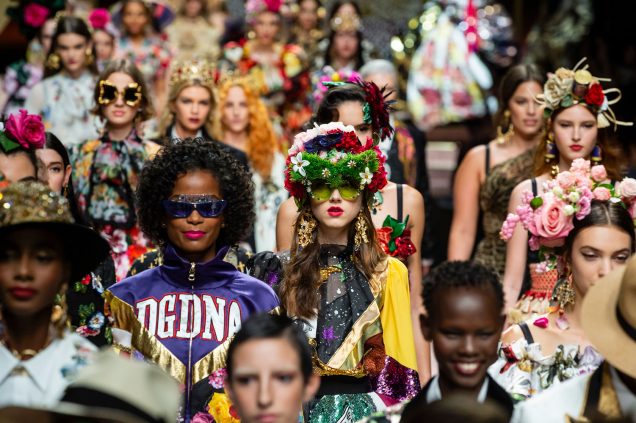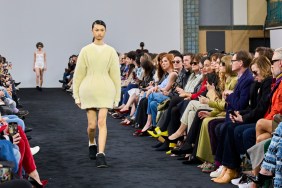We’ve come a long way from the days when nude crayons were the color of white people and Diane von Furstenberg’s decision to cast seven black models in her Spring 2008 show — more than any other label that season aside from maybe Baby Phat or Heatherette — felt revolutionary. Spring 2019 was the most racially diverse, size diverse and gender-inclusive fashion month ever and the labels that cast the most models of color had entirely nonwhite lineups. That said, there are still serious strides to be made in all the diversity categories, especially in Europe. As has often been the case in seasons past, New York’s monumental achievements skewed the averages to an almost deceptive extent, particularly when it comes to size representation.
RACE
Spring 2019 was the most racially diverse fashion month ever. After examining 229 shows and 7,431 runway castings, we found that 36.1 percent of all castings across New York, London, Milan and Paris went to models of color. (Essentially two in every five models were people of color.) That’s a significant — 3.6 point — increase from Fall 2018’s 32.5 percent. For comparison, when we first started keeping track of runway diversity back in Spring 2015, only 17 percent of runway models were nonwhite.
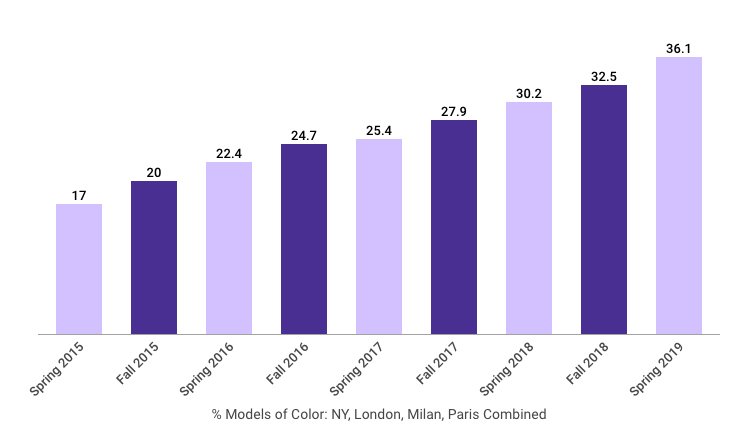
New York is typically the most racially diverse of the four main fashion weeks and Spring 2019 kept with tradition. Additionally, it was the most racially diverse New York Fashion Week on record. Nearly half — 44.8 percent — of the models cast were women of color, a 7.5 point jump from Fall 2018’s 37.3 percent. Needless to say, New York’s numbers outpaced the other cities by a long shot and helped raise the global average significantly.
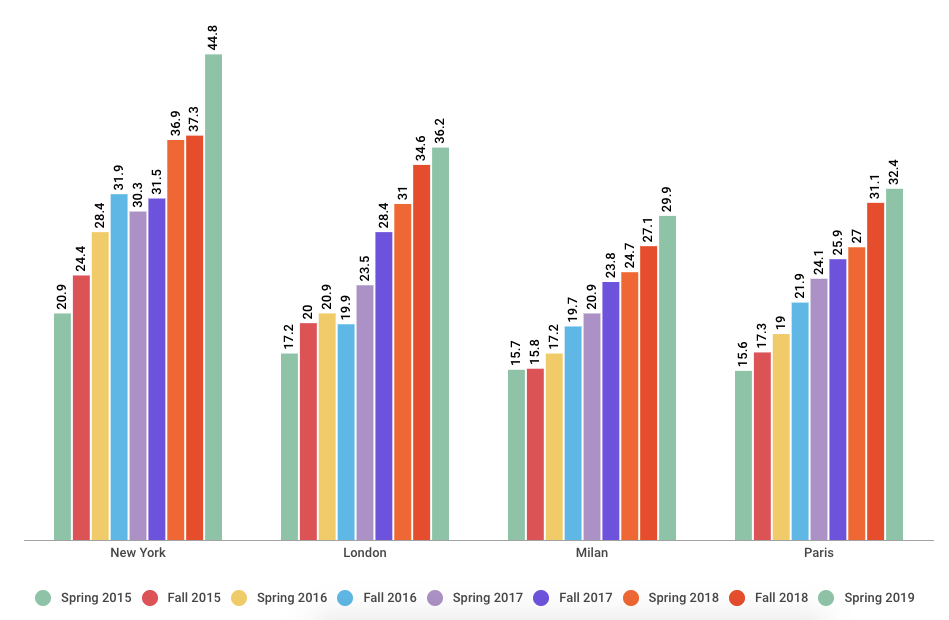
London had the second most racially diverse runways for the fourth season running. Spring 2019’s London shows featured 36.2 percent models of color, a slight — 1.6 point — increase from the previous season’s 34.6 percent and an all-time high for the city. (Note: London’s tallies do not include the masked models who walked at Richard Quinn and Gareth Pugh.)
Meanwhile, in Paris, models of color made up 32.4 percent of runway castings, again a minor — 1.3 point — increase over Fall 2018’s 31.1 percent, but still a record high for the city. Milan, which consistently lags behind the other cities in terms of racial diversity, featured only 29.9 percent models of color, up 2.8 points from the Fall 2018 season, which had 27.1 percent. Note: Milan is the only city that has yet to cast over 30 percent models of color on its runways. Still, its racial diversity numbers continue to improve steadily. In fact, the number of nonwhite model castings in Milan, London and Paris has now been on an upward trend since Fall 2016. (New York’s numbers dipped between Fall 2016 and Spring 2017.)
Also, all but one of the shows we examined featured at least one model of color, the exception being Milan-based designer Daniela Gregis.
TOP MODELS
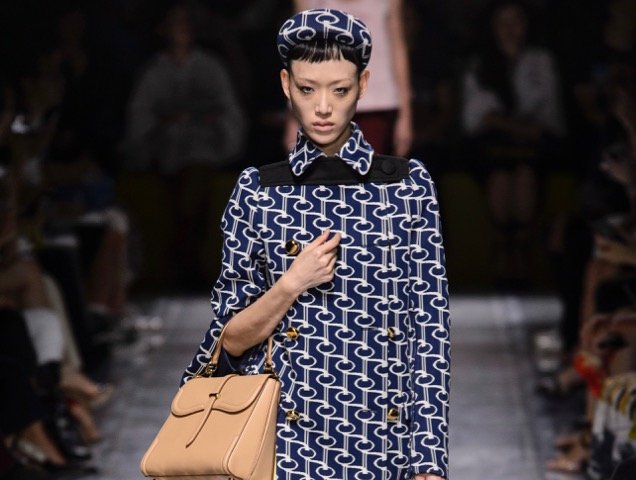
Of the 10 models who racked up the most Spring 2019 runway appearances, half were women of color. That’s the same proportion we saw last season (when 6 out of the 12 top models were nonwhite). South Korean model Sora Choi booked 35 shows, making her the second-most-popular model this season. (American model Rebecca Longendyke was the most-cast model of Spring 2019 with 43 runway appearances.) The remainder of the top 10 includes Sudanese-Australian model Adut Akech, Korean model Hyun Ji Shin and New York Fashion Week favorite Yoon Young Bae, each of whom booked 33 shows, as well as Chinese model He Cong, who booked 28. Per usual, no transgender, plus-size or over-50 models made the top 10.
PLUS-SIZE
After a disheartening Fall 2018 season wherein only 30 plus-size models walked in a total of 10 shows across all four cities — eight fewer than in Spring 2018 and the first regression in plus-size castings since Fall 2016 — casting of plus-size talent reached an all-time high for Spring 2019. A total of 54 plus-size models appeared in 15 Spring 2019 shows, nearly doubling the previous season’s number.
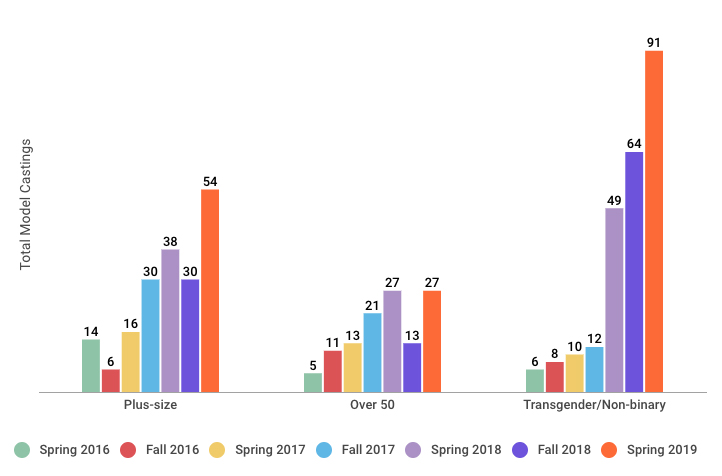
Still, this past fashion month was hardly a size-inclusive affair: those 54 plus-size castings only equate to 0.73 percent of total castings. But progress is progress and this is the most we’ve seen in years. Considering Fall 2018’s 30 plus-size castings (0.39 percent), Spring 2018’s 38 (0.46 percent) and Fall 2017’s 30 (0.43 percent), each made up about 0.4 percent of overall model castings for those respective seasons, Spring 2019’s long-awaited 0.34-point increase represents a big win.
Unfortunately, fashion’s body diversity movement has yet to go global. As is typically the case, the improvements seen in the plus-size category came mostly at the hands of New York designers, with Chromat (13 plus-size castings), Savage x Fenty (12) and Christian Siriano (8) leading the charge. Rounding out the pack were Cushnie (3), Prabal Gurung (2), Michael Kors (2), Tome (2), Gypsy Sport (2), Yuna Yang (2), Eckhaus Latta (1), Collina Strada (1) and Sies Marjan (1). (For the full list, head to our New York Spring 2019 Diversity Report.) Additionally, 35 of New York’s 42 plus-size castings went to women of color, two to plus-size women over the age of 50 (Emme and Mia Michaels at Chromat).
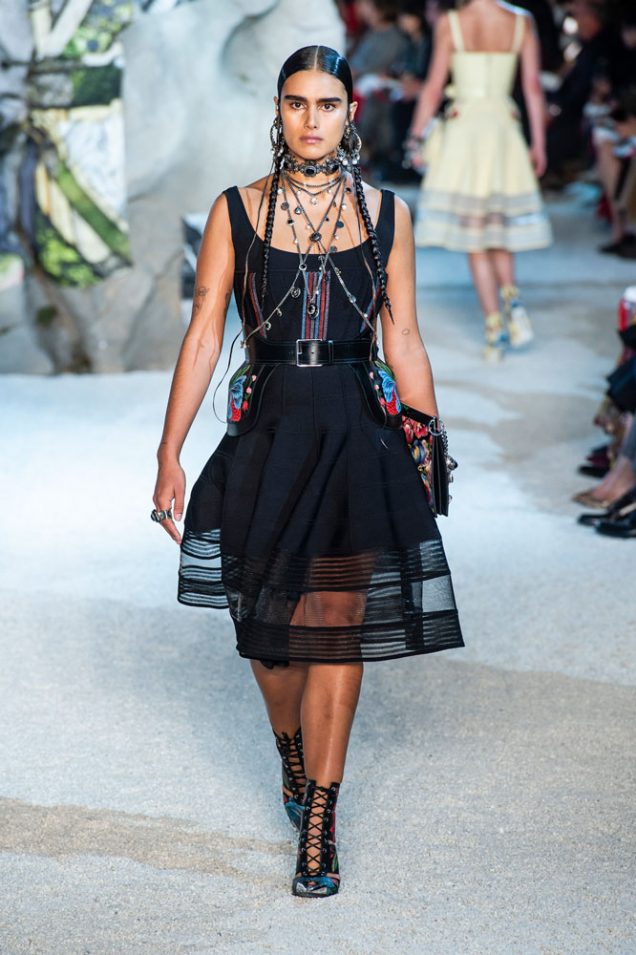
By comparison, only three European brands made any effort toward size inclusion and attempts to bring in intersectionality were even scarcer. London Fashion Week — known for its spirit of risk-taking and age inclusiveness yet strangely (unforgivably) exclusionary when it comes to models above a U.K. size 10 — saw one designer, Nicholas Kirkwood, hire one plus-size model, Raisa Flowers. For context, since we first began tracking body diversity on the runways in Spring 2016, this is only the second season any plus-size models were cast in London (Spring 2018 had two). Are designers not aware the U.K. plus-size market was estimated to be worth over $8.5 billion in 2017?
Milan, which consistently lags in terms of racial, size and gender diversity, surprisingly had the most plus-size castings (three) of the three European fashion capitals. Sadly, that’s the highest number of plus-size models ever booked in Milan. Not to mention, Domenico Dolce and Stefano Gabbana — and casting director Décio Santos — were responsible for all three of those hirings. Dolce & Gabbana’s street-cast, over-150-look show celebrating “the okay-ness of identity” featured models of a wide range of ages, sizes and body types. The eclectic, electrifying group included (white) plus-size models Ashley Graham, Annie Mazzola and Tess McMillan (Texan, rising star, new face of Marc Jacobs Beauty). Note that Dolce & Gabbana typically puts on the most diverse show of the week — no other plus-size models have walked in Milan aside from in Fall 2017 and both were at Dolce & Gabbana then, too.
Paris had just one plus-size model casting: Jill Kortleve at Alexander McQueen, another one of those rare Europe-based labels known for its “diverse” — at least by European standards — lineups. That’s the lowest Parisian plus-size showing in four seasons: Fall 2018 had three, Spring 2018 two, Fall 2017 two. (Spring 2017 had zero.) Given that Paris Fashion Week is typically a drop more size-diverse than either London or Milan, we’re disappointed.
Looking at intersectionality, only two of the five plus-size models to walk in Europe this season were also of color (Kortleve and Flowers) and no non-binary or transgender plus-size models were cast at all — not in Paris, Milan, London or New York.
TRANSGENDER/NON-BINARY
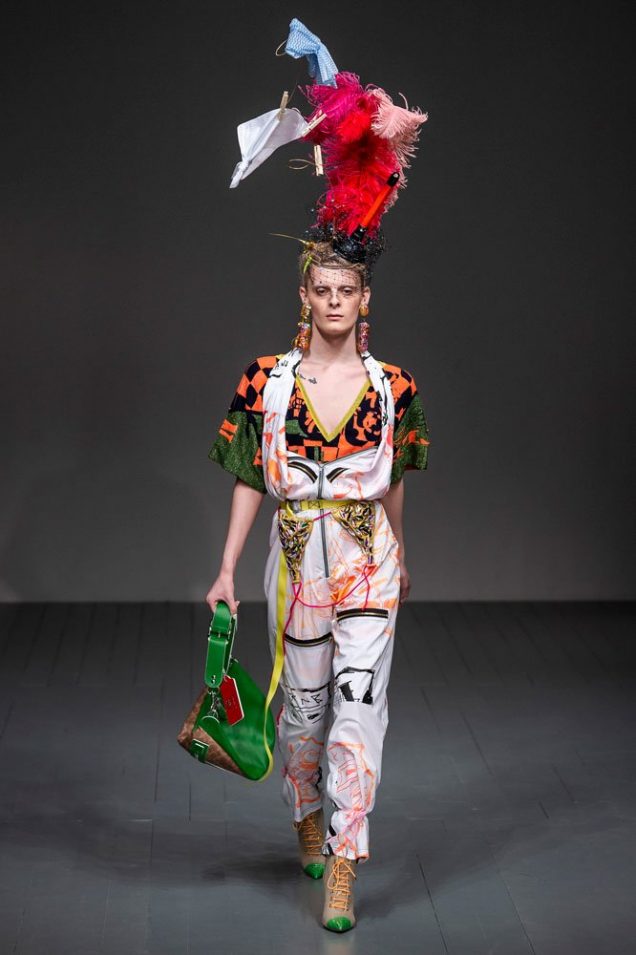
The Spring 2019 runways saw a tremendous boost in terms of non-binary and transgender visibility. Trans women and non-binary models landed a record 91 runway spots this season (accounting for 1.23 percent of the total), an all-time high for the industry. Additionally, designers in every city except Milan cast more models who openly identify as transgender or non-binary than ever before.
Moreover, trans and/or non-binary models saw the sharpest increase in representation of any category outside of race. Eighty three openly transgender women and eight non-binary models walked in a total of 52 Spring 2019 shows, besting Fall 2018’s showing (56 transgender women, 8 non-binary models, 52 shows) by 27 and Spring 2018’s numbers (45 transgender women, 4 non-binary models, 47 shows) by 42.
It’s important to keep in mind that as recently as the Fall 2017 season, trans women and non-binary models were by far the least-represented group — and that back in Spring 2016, when we first began tracking their runway presence, we counted only six. So while trans and non-binary models do still only make up a tiny fraction of those on the runway, it’s telling that this season they were the only nonracial group to pass the one-percent mark. Not to mention the spread and caliber of the shows they landed was truly impressive.
It practically goes without saying that New York — consistently the most diverse of the four main fashion weeks — had the most positive runway stats when it came to gender inclusion. Over half (53) of the season’s 91 castings in this category happened in New York, up from 33 last season. London saw 16 trans women and non-binary models cast, up from 10 in Fall 2018 (the biggest jump of any European city), Paris 16 (two more than during the previous season), Milan six (one less than its Fall 2018 season).
Unsurprisingly, New York also won on the intersectionality front: more than half (29) of the city’s 53 trans/non-binary castings went to models of color, whereas in Europe only two transgender or non-binary models of color were cast, both in London (Dara Allen at Erdem, Elijah Che at Gareth Pugh). Inexcusable, given that a total of 38 trans/non-binary models walked in London, Milan and Paris. Also, no plus-size or over-50 models who openly identify as trans or non-binary were cast in any of the fashion cities.
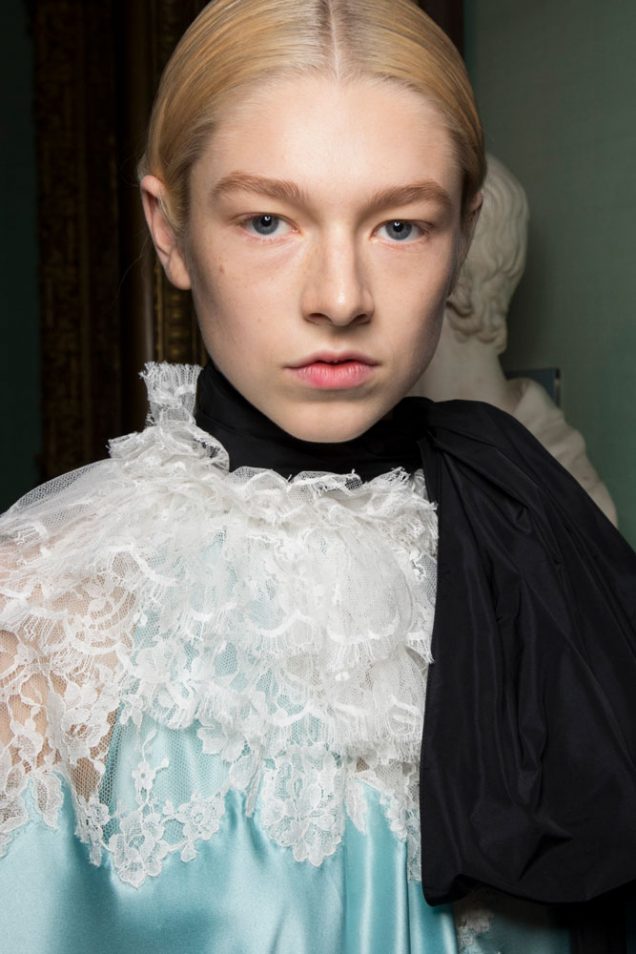
Relatedly, while we applaud the transgender and non-binary runway talent who landed work in Europe solidifying their careers, the degree to which European designers deserve to be congratulated is debatable. Europe’s — and especially Milan’s — trans/non-binary castings smacked of tokenism: the models were predominately white because runway spots repeatedly went to the same white models. In reality, only three transgender women worked at anything like the frequency of their cis counterparts: Hunter Schafer (who walked 15 shows in Europe, two in New York), Massima Lei (eight in Europe, two in New York) and Teddy Quinlivan (six in Europe, five in New York).
Schafer landed seven of London’s 16 trans/non-binary castings, walking at Erdem, Mary Katrantzou, David Koma, Ports 1961, Chalayan, J.W.Anderson and Gareth Pugh, where she was joined by non-binary model Che. Lei walked in five London shows: Natasha Zinko, Toga, Erdem, Ashish and Fashion East. Allen joined Schafer and Lei at Erdem, bringing the show’s total trans model count to three, the most of any London runway. Lastly, Matty Bovan (whose collection Vogue named one of the best of the month) broke with convention by casting trans model Gigi Hari and non-binary model Finn Buchanan, their only appearances of the week.
Nearly all (five out of six) of Milan’s trans/non-binary castings went to Schafer, who popped up at MSGM, Ermanno Scervino, Marco de Vincenzo, Emilio Pucci and Byblos. The remaining runway spot went to Oslo Grace, who identifies as both trans and non-binary and walked at Giorgio Armani.
Runway-regular-turned-activist Quinlivan walked in six Paris shows — Zadig & Voltaire, Louis Vuitton, Redemption, Paco Rabanne, Chloe, Maison Margiela — the most of any trans/non-binary model this season. Meanwhile, Schafer and Lei landed three Paris gigs apiece: the former walked for Poiret, Christian Dior and Rick Owens, the latter for A.W.A.K.E., DROMe and Courrèges. Grace joined Lei at Courrèges; Buchanan, the sole non-binary model at Miu Miu, joined Quinlivan at Maison Margiela. Balenciaga, which is often dragged for its whitewashed lineups, took a stab at diversity, casting trans model Sara Oliver Wight (along with transvestite Linda DeMorrir, but more on that later).
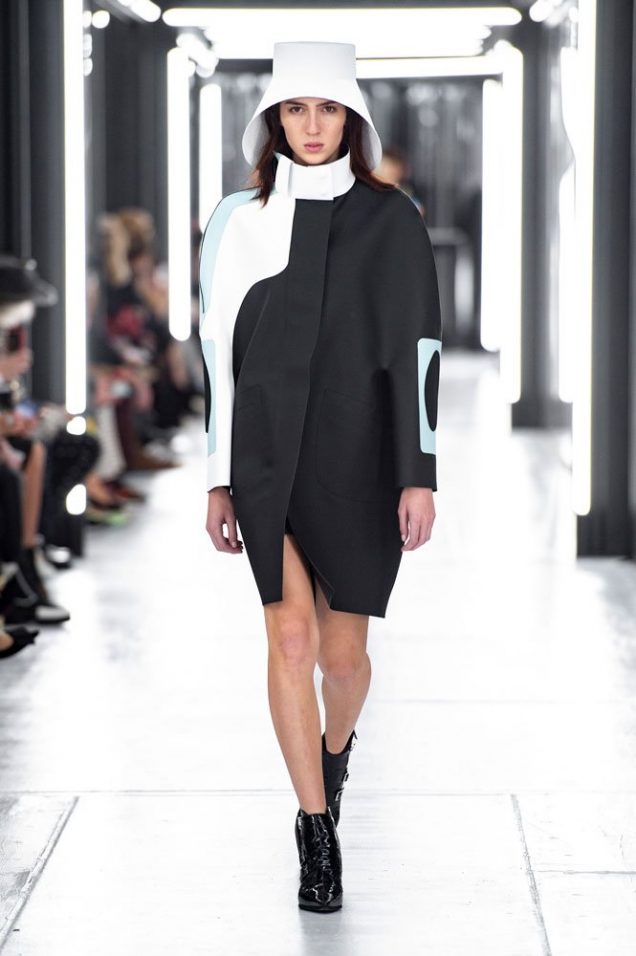
Again, while the model names certainly get repetitive, the scope of the hirings is staggering — it’s clear it’s no longer just fringe and activist brands giving trans and non-binary talent their due. And for a model, high-profile runway gigs are invaluable: they bring with them name recognition and greater career opportunities.
That said, niche, politically-minded brands are still the ones doing the heaviest lifting. Spring 2019’s noteworthy progress in trans/non-binary representation would not have been possible without New York shows like Marco Marco (which had an all-trans cast, including 15 trans women), Gypsy Sport (which cast seven trans women and one non-binary model), Opening Ceremony (four trans models, one of them non-binary), The Blonds (three trans women, one non-binary model) and Chromat (three trans models this year, plus we’ll forever celebrate Becca McCharen-Tran as one of the earliest adopters of the cause). For a more in-depth look at the 20 New York shows that featured trans/non-binary models, head over to our preliminary Spring 2019 report.
On that note, it’s no coincidence that three of the above brands — Opening Ceremony, The Blonds and Gypsy Sport — chose this season to take representation one step further, using their runways to shine light on the LGBTQIA+ community by casting drag performers. (Fashion designers have long been inspired by LGBTQIA+ culture, but it’s rare that they invite members of the community to model their designs, which made these castings that much more significant.) Opening Ceremony’s nontraditional Spring 2019 runway had a cast of 100 percent LGBTQIA+ models, 21 of them drag queens. Gypsy Sport’s remarkably diverse cast included three drag performers, The Blonds’ one. Like other movements that call into question dated social mores, this one had legs: overseas, Demna Gvasalia of Balenciaga cast multidisciplinary artist and transvestite DeMorrir. (To clarify: We only include female and non-binary models in our data. Thus, we did not count drag performer or transvestite castings toward our total for the trans/non-binary model category unless said individuals identify as non-binary as opposed to male. We thought designers’ efforts toward LGBTQIA+ inclusion deserved a nod, however.)
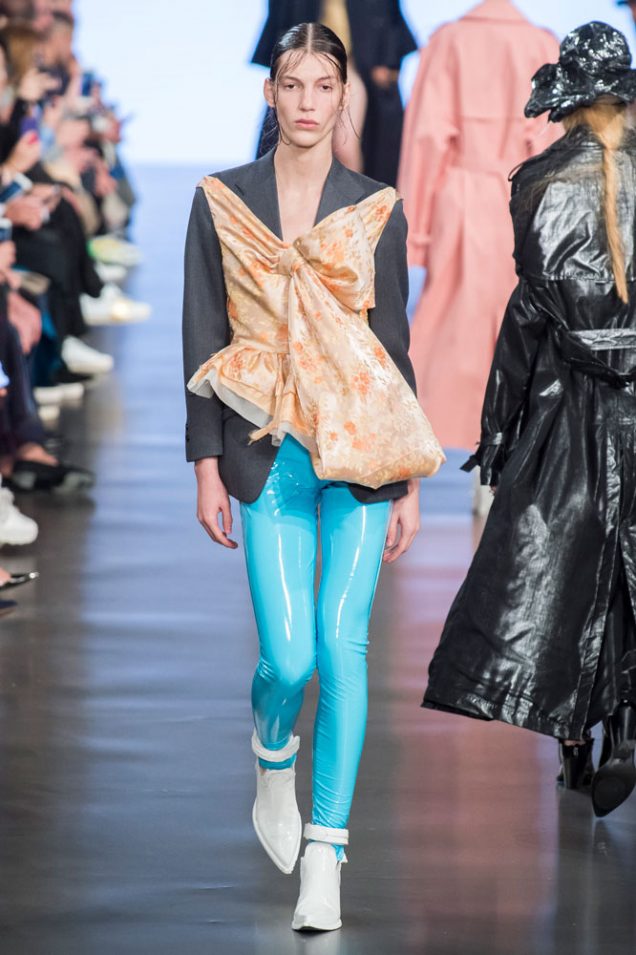
Now, not to pull a Vogue and conflate gender fluidity with gender-neutral dressing, but it’s worth pointing out that, in addition to putting trans and non-binary models and drag performers on their runways, designers across all four cities encouraged their audiences to reject gendered conventions of dressing in the name of freer self-expression. At Vaquera, male models walked in hot pink ruffled crop tops; Courrèges put boys in slouchy, knee-high boots and patterned stockings; Maison Margiela ornamented them with bows. Helped along by the runways, the rules of who can wear what — per dated notions of gender identity — are eroding.
AGE

Women age 50 and above are still greatly underrepresented in proportion to their spending power — and, more generally, the percent of the population they account for — at least on the runways. This season, women in their 50s, 60s and upward were the least represented of all the groups, as has been the case for the past three seasons (beginning in Spring 2018 up to and including Spring 2019). What’s more, this was the category that saw the least drastic change.
That said, their numbers did improve significantly. New York had 12 models age 50 or above, Milan nine, London and Paris three apiece, bringing the season total to 27, or 0.36 percent of those on the runway. That’s 14 more than in Fall 2018 and on par with Spring 2018, previously the most age-diverse season on record. (Spring 2019 and Spring 2018 now share the title.) Plus, as with transgender and non-binary models, there’s something to be said for the types of brands that hired over-50 models.
Another silver lining (no pun intended): European designers were responsible for just over half (15) of the season’s mature model castings. (Interestingly, they seem much more eager to hire gray-haired women than they do those with a greater-than-25-inch waist.) On the downside, more than half (8) of those 15 castings took place at one show: Dolce & Gabbana in Milan.
London’s numbers were consistent with those we’ve seen for the past two seasons (Fall 2018 and Spring 2018), but four fewer than Fall 2017’s seven — sadly the most over-50 model bookings the city’s seen to date. All three castings took place at one show: Temperley London, where Helen McCrory, Ellen von Unwerth and Diana Temperley (the designer’s mother) walked.
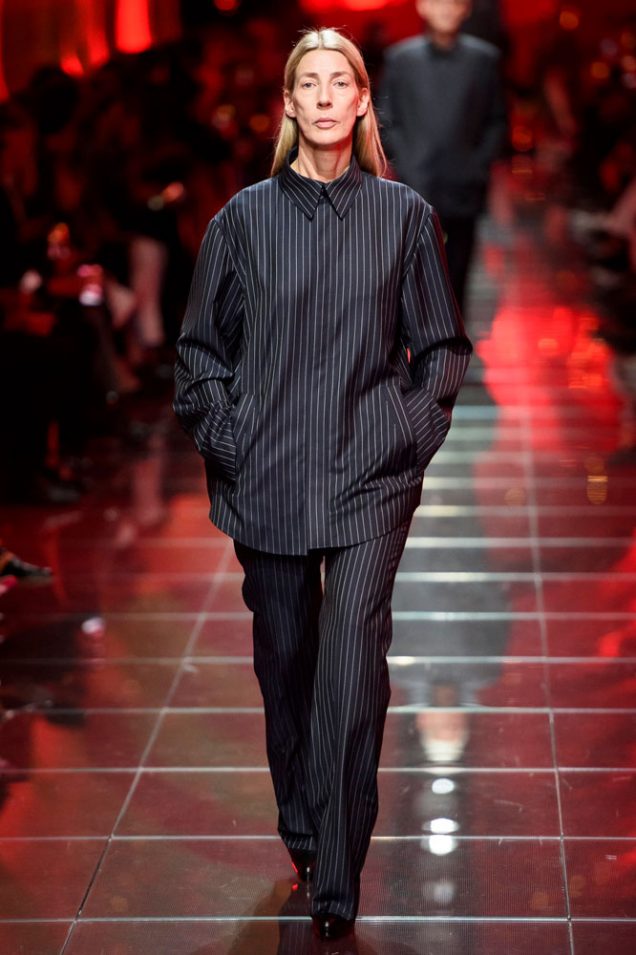
As stated, Milan had the most over-50 model appearances of any city outside New York — and the most in its history — again thanks to Dolce & Gabbana’s sprawling Spring 2019 show. (Fall 2018 had only two; Spring 2018 trails closely behind with seven.) Dolce’s all-star cast included cultural icons like Monica Bellucci, Isabella Rossellini, Carla Bruni, Marpessa Hennink and Maye Musk, to name a few. Additionally, designer Daniela Gregis (known for her egregiously whitewashed lineups) hired one over-50 model.
Spring 2019 was likewise the most age-diverse New York Fashion Week on record. Sies Marjan, Chromat, Tome, Polo Ralph Lauren and Zero + Maria Cornejo each hired two over-50 models, Calvin Klein and Collina Strada one. (For details on said castings, click here.)
In Paris, over-50 models appeared in two highly influential shows. Artist Britta Dion and Swedish business magnate Britta Lund walked at Balenciaga; modeling legend Kristen McMenamy opened Valentino, an honor rarely bestowed upon, ahem, “alternative” models. All in all, three castings is an improvement on Fall 2018’s zero, but far short of Spring 2018’s seven, and nowhere near the city’s record (nine, in Fall 2016).
As far as intersectionality goes, Tessa Crawford, another Dolce recruit, was the only over-50 woman of color to walk in Europe. (If the name doesn’t ring a bell, she’s the mother of reality TV star Azteca Henry.) In New York, Tome and Zero + Maria Cornejo were the only shows to feature a nonwhite woman in this age group, bringing the grand total of over-50 racial minorities cast to three. Finally, Chromat was, yet again, the only brand to hire any plus-size women over age 50 (Emme and Mia Michaels) and transgender women over age 50 were left out completely.
MOST AND LEAST DIVERSE SHOWS
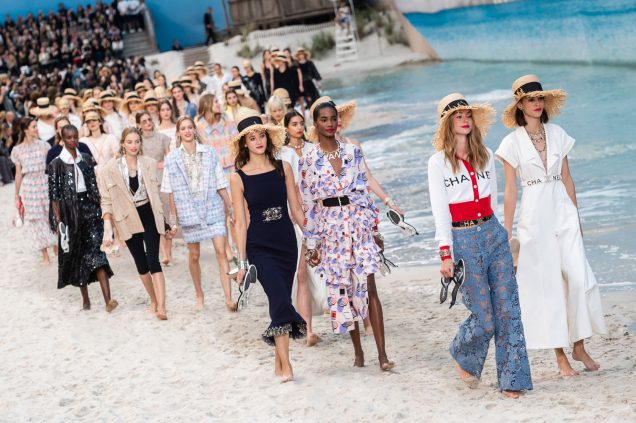
The only Spring 2019 show that didn’t feature at least one model of color was Milan’s Daniela Gregis, which featured 13 models, all of them white. To make matters worse, this is the second consecutive season wherein Gregis has cast no models of color. Puzzling, given that this was one of the few European brands to hire an over-50 model.
Of course, there were plenty of other brands that didn’t do enough to adequately represent minorities. Rounding out Milan’s list of offenders were Les Copains, which hired 1 out of 21 (4.76 percent) nonwhite models, Genny with 2 out of 25 (8 percent) nonwhite models and Elisabetta Franchi, where only 3 of the 28 catwalkers were women of color (10.7 percent). In London, Ashley Williams hired just 4 out of 30 nonwhite models (13.3 percent), Delpozo 5 out of 32 (15.6 percent). Even New York, where nearly a quarter of the shows we examined featured at least 50 percent models of color, had some slackers: Zang Toi cast only one model of color in a lineup of 14 (7.14 percent), Tadashi Shoji 2 out of 18 (11.1 percent).
But, by far, the greatest letdowns of the Spring 2019 season came from Paris, where many of the month’s most influential shows failed to break the 20 — or even 15 — percent diversity mark. We refer here to Maison Margiela (11.1 percent), Gucci (13 percent), Céline Celine (15.6 percent), Comme des Garçons (17.6 percent) and Chanel (18.3 percent). Zadig & Voltaire fell to the very bottom of the pile with 10.5 percent nonwhite castings. While Comme des Garçons’ poor score is hardly a surprise — it’s typically one of the least-diverse shows of Paris Fashion Week, if not the month — Margiela’s white-dominated runway didn’t jive with its fine-pointed emphasis on other forms of inclusivity, namely gender.
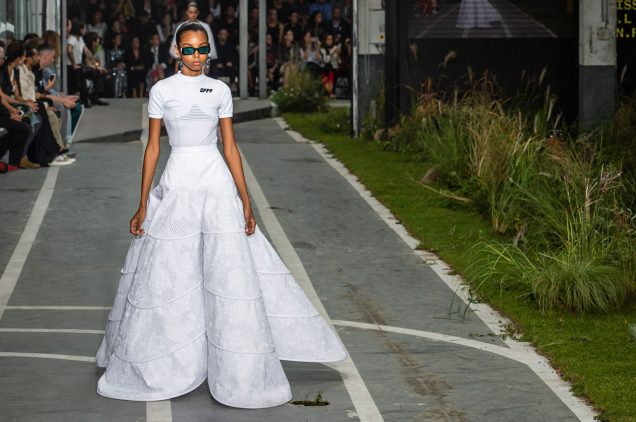
Now for the fun part. The most racially diverse shows of the most racially diverse season ever were, in order: Pyer Moss (100 percent models of color), Claudia Li (100 percent models of color), Chromat (91.7 percent models of color), Esteban Cortazar (88.5 percent models of color), LaQuan Smith (76.5 percent models of color), Gypsy Sport (76 percent models of color), Prabal Gurung (75.6 percent models of color), Savage x Fenty (71.7 percent models of color), Christian Cowan (71.4 percent models of color), Cushnie (66.7 percent models of color).
As is often the case, of the 10 shows that topped in racial diversity, the majority (nine) came from New York, where, again, 23 of the 76 shows we examined featured casts that were at least 50 percent nonwhite. (Read that exhaustive list here.) The only European show to make the list was Paris’ Esteban Cortazar, which came in third.
Not that Cortazar’s was the only European show worthy of recognition. In London, Halpern cast 64.3 percent models of color, Simone Rocha 57.9 percent, Fashion East 53.1 percent. Milan had its standouts, too, namely Emilio Pucci (60.7 percent models of color), Roberto Cavalli (56.8 percent models of color) and Missoni (53.5 percent models of color). And helping Cortazar offset the failures of Chanel et al. were Parisian shows like Koché (62.2 percent models of color), Jacquemus (57.1 percent models of color) and Off-White (55.3 percent models of color). Note that Missoni, Jacquemus and Off-White regularly come out on top in terms of racial diversity.
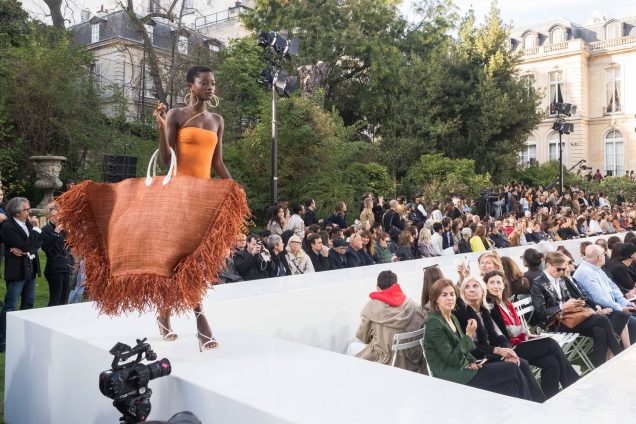
Which brands made a concerted effort to feature more than one type of diversity in their shows — i.e., not just models of color, but also models of various body types, ages, sizes, abilities and gender identities? In New York, there was Chromat, Gypsy Sport, Prabal Gurung, Savage x Fenty, Tome, Christian Siriano, Michael Kors, The Blonds, Opening Ceremony, Marc Jacobs, Coach 1941 and Marco Marco; in London, Erdem; in Milan, Dolce & Gabbana; in Paris, Balenciaga. Generally speaking, it was a decent mix of early diversity adopters, “disruptive” young labels and forward-thinking luxury brands.
Chromat was responsible for the most plus-size castings of the month, two of which went to women over the age of 50. Becca McCharen-Tran also cast cancer survivor and amputee Mama Cax, hijab-wearing model Kadija Diawara, three trans women and close to 92 percent models of color.
Gypsy Sport had 76 percent models of color, three drag performers (one of them non-binary), six transgender models, one disabled model and two plus-size models. More than three-fourths of the models at Prabal Gurung were nonwhite, one of whom was plus-size, another transgender. (Note: Gurung hired two plus-size models in total.) Savage x Fenty featured ample racial (almost 72 percent models of color) and size diversity (12 plus-size models) plus two pregnant models.
Tome employed 21 models of color as well as two plus-size models and two models over the age of 50; Christian Siriano had one of the most size-inclusive shows of the season (with eight plus-size models) in addition to being almost 59 percent nonwhite.
Michael Kors featured 56.4 percent models of color, two plus-size models (one of them mixed race) and one transgender model; Marc Jacobs and Coach 1941 did especially well in terms of gender inclusiveness — each hired three models in the transgender/non-binary category. Marco Marco made history by hiring an entirely transgender cast, 60 percent of whom were of color. Opening Ceremony likewise populated its show with members of the LGBTQIA+ community, four of them trans, two of them non-binary, 43 percent of them people of color. Meanwhile, The Blonds starred almost 59 percent models of color, three transgender models (all of them nonwhite) and one non-binary model.
Erdem, though only 31 percent racially diverse, hired more transgender models (three) than any other European brand — and one was a woman of color. Similarly, Balenciaga’s runway wasn’t especially ethnic (with 34 percent models of color), but it did feature two over-50 women, one trans model and one transvestite.
Last but not least, Dolce & Gabbana had one of the most impressive lineups of the season. The Italian fashion house cast three plus-size models (the most of any European show, not that that’s saying much) as well as eight models over the age of 50, one of them a woman of color, making it the most age-inclusive Spring 2019 show, period. On the downside, only 30 of its 154 models (19.5 percent) were women of color. (When awarding the most across-the-board-diverse European shows, we’re forced to set the bar lower.)
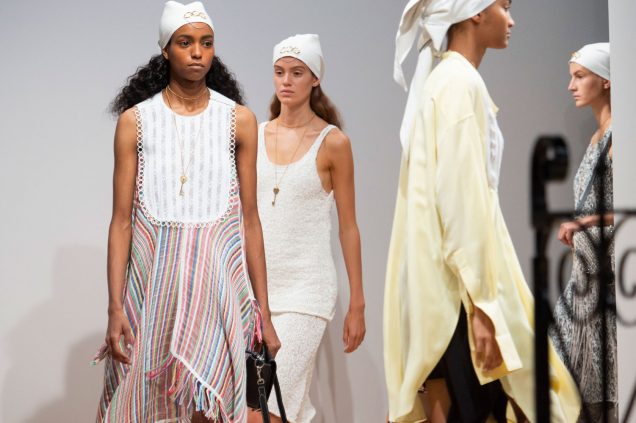
Here’s a fun exercise: let’s look at the totals without New York. Overall racial diversity drops to 32.9 percent. That’s 0.4 of a percentage point better than last season and 3.2 points below the actual figure for Spring 2019 — not too bad. Plus-size model castings drop to five as opposed to 54; over-50 model castings to 14 rather than 27; transgender and non-binary castings to 38 instead of 91. We think we’ve made our point. Designers may have gotten the racial (and, to some extent, gender) inclusivity memo, but it’s time those in Europe stopped inviting plus-size models to sit front row, pose for pictures and post about the shows and actually put them in some. And designers in all four cities need to do more to combat ageism.
Additional reporting by Mark E.
Only women and non-binary models are included in this data. Models of color are categorized as those who are nonwhite or of mixed backgrounds. Fall 2018 collections that showed during the Spring 2019 season are included in this report.
